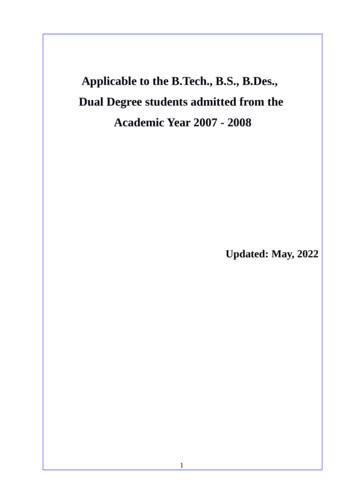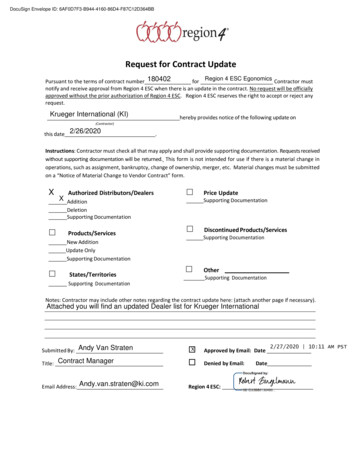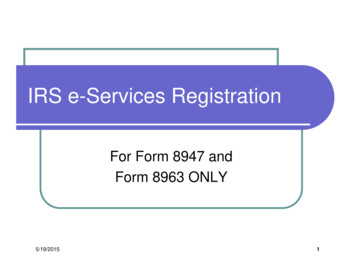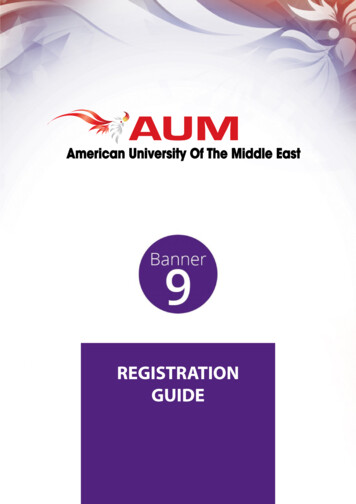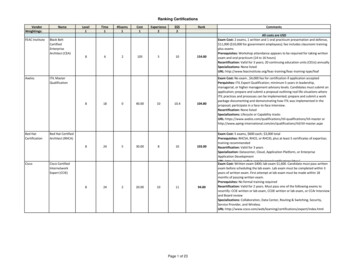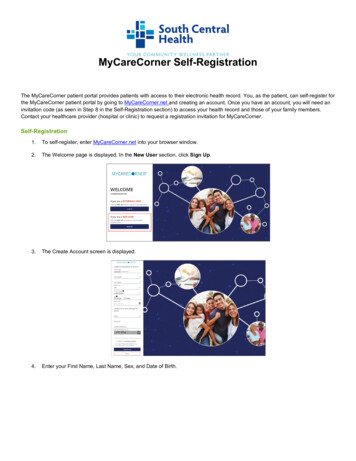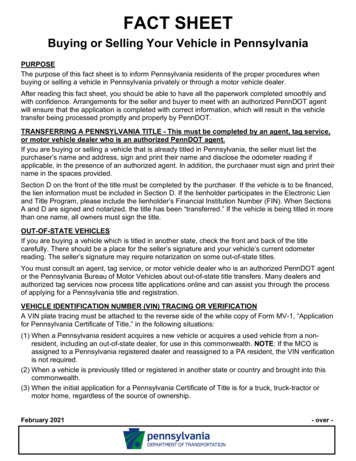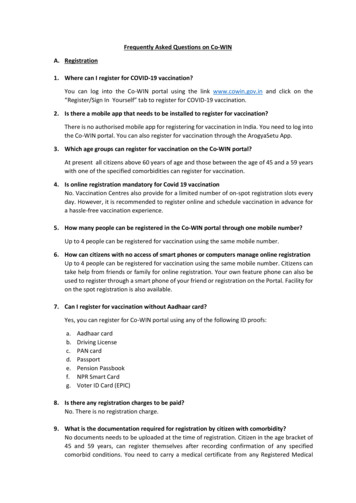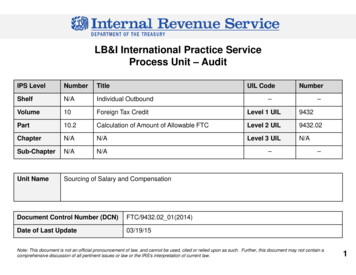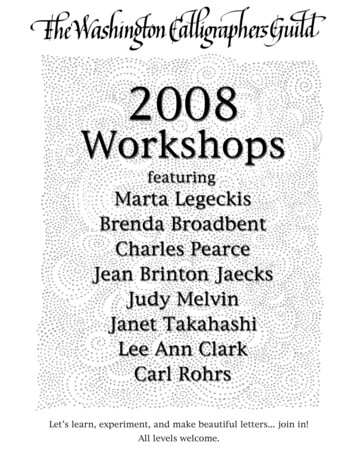
Transcription
RegistrationFill out the Registration Form and mail it, along with a #10stamped, self-addressed envelope and check made out toWashington Calligraphers Guild for the appropriate amount to:Kara Koppanyi744 Camberley Circle, #T-1Baltimore, Maryland 21204Telephone registrations are not accepted, but if you have a question, youmay call Kara at 410.769.9040 or e-mail her at karalko@earthlink.net .You may also call Christine P. Tischer at 301.745.4633 or e-mail her atchris@calligraphybychris.com .CancellationsRefunds are given only if the workshop is cancelled by WCG, your placeis actually filled from our waiting list, or if you find someone to takeyour place. Please give us as much notice as possible. All changes inregistration must be handled by Kara Koppanyi. If you cannot make theclass, you must call Kara at 410.769.9040 at least 24 hours in advanceof the workshop so that she may notify any wait-listed people.HousingHosts and drivers are needed for our out-of-town instructors, and areeligible to receive a 25% rebate on class tuition. To volunteer, pleasecontact Vicki Futscher by e-mail at futscherv@yahoo.com or phonenumber 703.593.7643.MonitorsThe monitor is responsible for introducing the instructor, checking enrollment, ensuring coffee supplies and critique forms are available, andenlisting participants to set the room in order at the close of the session.To volunteer, contact Jennifer Kolls by e-mail at kollsjl@state.gov orphone number 703.753.0081.ReviewsWe need volunteers to write reviews of our workshops to be publishedin the WCG Bulletin or Scripsit. The review submitted must need little orno editing. Please e-mail Terri Barber at terribarber@gmail.com .Registration Information and FormPlease mark the box for each workshop for which you wish to register.Keep in MindRegistration begins immediatelyand will continue until four (4)weeks prior to the beginningof the class. (Classes are fullat 16. If there are not enoughregistrants prior to the workshopdeadline, it may be cancelled.)Registration is assigned in theorder received, with preferencegiven to WCG members. Youwill be notified if you are in theclass or on the waiting list. If theclass is full, your workshop feewill be returned to you.Classes offered this year are forall skill levels, with the exceptionof Marta Legeckis’s class, whichis for calligraphers who know atleast two hands.Creativity in Certificate & Award Design w/Marta Legeckis—March 29 & 30 125 members / 150 non-membersParallel Pen and Zentangle with Brenda Broadbent—April 5 62.50 members / 75 non-membersWhich Paper? and Tool Time with Brenda Broadbent—April 6 62.50 members / 75 non-membersLetters from Hell with Charles Pearce—April 12 & 13 250 members / 300 non-membersIlluminated Manuscript Letter with Jean Brinton Jaecks—October 4 & 5 125 members / 150 non-membersSpontaneous Combusion with Judy Melvin—October 10, 11, 12, 13 240 members / 280 non-membersContemporary Pointed Pen with Lee Ann Clark—November 15 & 16 125 members / 150 non-membersModern Moves and 20th Century Masters with Carl Rohrs—December 6 & 7 125 members / 150 non-membersNameAddressCity, State, Zip CodePhone Numbers (home) (work)E-mail AddressAre you a WCG member? Yes No
Creativity in Certificate and Award Designwith Marta LegeckisMarch 8 & 9 (Saturday & Sunday) at Mt. Vernon Government Center9:30am–4:30pmIntermediate calligraphers who know at least two handsWhen faced with designing an award or certificate, the usual tendency is to think “centered”or “flush left.” In this workshop, we will go through various steps in order to introduce afreer way of thinking when designing these awards. We will look into how to make themmore personal, thereby reflecting either the reason for the award or something about therecipient. Of course, the formal awards are not just going to fade away. So, attention willbe given to ways of making them have a more contemporary look and to avoid producinganother run-of-the-mill award. Participants are encouraged to experiment with color,different papers, and tools. Come prepared to think outside the box!Supply ListAbout MartaMarta Huley Legeckis has been practicing the art of calligraphy for over 30 years. Shereceived her Bachelors and Masters degrees in Fine Arts at the City University of NewYork (commonly known as City College). Marta was turned-on to calligraphy during oneof her graphic design classes. Over the years, she developed this interest into a freelancebusiness. A resident of the Washington, D.C. area for the past 32 years, Marta’s clientsinclude the White House, the State Department, the Vice-President’s office, the NationalGallery and various embassies. Her specialty is the “one of a kind” award that reflectseither something about the recipient or the reason for the award. One of hermain clients for this type of work is the Department of the Interior. Martais a former President, Vice-President, and Workshop Chairman of theWashington Calligraphers Guild. She was also the Co-Director ofLetterforum 2006. One of her main goals is to make the publicaware that good letter design requires study and practice;it doesn’t just flow out of the pen!pencil/sBasic suppliesany papers you like to use or some that youhave not had the nerve to trygouache and watercolors (do not go out and buythem as Marta will bring some to share)tracing paperlayout papervariety of nibs (or brushes if you prefer)ink (Sumi or for practice: Quink, Pelikan 4001,walnut ink)T-squares and triangles (don’t forget!)
Parallel Pen and Zentanglewith Brenda BroadbentApril 6 (Saturday) at Columbia Art Center9:30am–4:30pmAll skill levels welcomeSupply Listany Parallel Pens & their color cartridgesyou already own12-20 sheets of any practice paper11 x 14-inches or largerParallel Pen Wizardry Book if you have onetube of gouache or watercolor (any color)mixing pan & brushwater containereyedropper or pipette2-3 paper towelsspray bottle of glass cleaner (any brand)acrylic ink if you already have itParallel Pen Empowerment for Beginners and Experts!Use this sharp and convenient pen for fun AND professional work. Explore color blending,hairlines, textures and non-stop flourishing. We’ll load these pens with sumi ink, gouache,watercolor and acrylic ink.Parallel pens will be available for loan during class if you don’t have one. If your ParallelPens are empty, bring them to class empty. Pens with problems welcomed.You Can Zentangle!Zentangle invites everyone to create beautiful images from simple repetitive patterns. Thiseasy, meditative and fun exercise is relaxing, leads to unexpected results and providesa counterbalance to our increasing use of computers, mice, screens, and keyboards.Zentangle can create beauty, increase confidence, change your mood, improve focus,and stimulate creativity. We will create 2-6 Zentangles in the session. You, too, maybe thoroughly hooked as Brenda was after a seminar with artists & Zentangle inventorsMaria Thomas (of Pendragon) and Rick Roberts. Visit zentangle.com for examples.Which Paper? and Tool Timewith Brenda BroadbentApril 7 (Sunday) at Columbia Art Center 9:30am–4:30pm All skill levels welcomeSupply ListThere is a supply fee of 22 for the 25-sheetfine paper sampler, a waterproof travel palette,unusual gouaches and inks.questions about paperfavorite dip pens in a variety of sizescopperplate nibs & holders (if you want to knowhow they respond to paper testing in class)Pentel color brush or pointed brush size 1 or 2and/or a flat brush if you want to test brushestube or two of watercolor or gouache2-3 loading brusheswater containerHiggins Eternal black inkOptional (bring any you already have):Dr. Martin’s bleedproof white or pro white,Horizon brass pens, Coits, Automatics, RulingWriter, ruling pen, Parallel Pens, folded pensWhich paper? Choosing Paper for CalligraphyPaper enhances the art of calligraphy almost as much as the pen, brush and color.Learn to choose paper for different effects and purposes in this half day of hands-ontesting. Write on practice paper and an international assortment of watercolor, charcoal,printmaking, text weight, faux parchment and black papers with a variety of tools andfluids. We’ll talk about surface, weight, archival quality and sizing.Tool TimeBring your tool and supply dilemmas for an afternoon of fun and exploration! Afterdemos and comments you will have opportunities to experiment. Discover new toolsand become confident with some unusual ones, including the Ruling Writer, folded pens,GTech micron style pens, Horizon brass pens, walnut & iridescent ink tricks, peerlesswatercolors, metallic gouaches, waterbrushes, phantom liners, lining guides, magnifyingvisors, hot foil pen, adjustable oblique holders, Japanese screw punches. We’ll talk about“the right tool for the job” including basic ink and paper dilemmas.About BrendaWith the help of a mighty but tiny staff, Brenda Broadbent has operated Paper & Ink Arts,a catalog for art supplies, books and gifts for calligraphers, book, and paper artists formore than 25 years from a little town in rural Maryland. She has experience as a highschool English teacher and as a reference librarian in Prince George’s County.
On the Luscious, Nay, Lascivious“Letters from Hell” with Charles PearceApril 12 & 13 (Saturday & Sunday) at Columbia Art Center9:30am–4:30pmAll skill levels welcomeThere is a feeling held by a number of calligraphers that the best learning hand is theGothic Black Letter, and while it is true that there are two basic strokes in a Gothic handthere are many subtleties which require earnest study.and then, there are “Letters from Hell.”These manipulated Gothic letters caused one well-known calligrapher at one of theconferences to opine that he had never been so humiliated in all his life! Well, they arenot as bad as that. With a little practice and application the basics of these attractivemanipulated letters can be yours, and the more decorative and interesting ones will followas you become more proficient. There may be cursing and gnashing of teeth to beginwith, but all of this will change to sunny smiles and feelings of superiority very quickly.The basics of a Gothic hand remain pretty much the same no matter what you do withthem. They all require a “picket fence” look—a smilar amount of space inside the letter asthe width of a stroke and this one is no different. The change will be in the shape of thestroke, as you will see.About CharlesCharles Pearce is generally regarded as one of the world’s foremost calligraphers andlettering artists. As a young student at Camberwell School of Arts and Crafts, he formedan association with Donald Jackson, Scribe to her Majesty’s Crown Office at the Houseof Lords. Charles graduated with the equivalent of an MFA in the Lettering Arts.In 1970, he was made a Fellow of the Society of Scribes and Illuminators in London, themost prestigious award available to calligraphers. He moved to New York in 1980, wherehe was the first, and thus far, only, calligrapher ever to be granted Artist-in-Residencestatus by the city.He is the author of a number of books on calligraphy, including: The Little Manual ofCalligraphy and The Anatomy of Letters, both books widely recommended by teachersto their students around the world. He is himself a teacher of note, conducting workshopsand lectures around North America, Europe, and Australia. His work is to be found inmajor collections around the globe, including those of various members of the BritishRoyal Family. He is also an accomplished ceramicist, an article on his work having beenpublished in Clay Times.Numbered among his clients have been: British Petroleum, Liberty of London, Heal’s,Parker Pens, The Lincoln Center, The New Zealand Tourist Board, American Greetings,The Royal Mint, and The British Museum.Charles Pearce currently lives and works in Eureka Springs, Arkansas, where heencourages and welcomes inquiries about and visitors to see his work at his new studioin the woodlands of Hillspeak, just outside the town. Please call ahead for an appointment(501.352.0955). A full résumé and other examples of his work may be seen on hiswebsites: www.charlespearce.com and www.whiskeyspring.com .Supply Listlots of layout paper (14 x 17-inch or bigger)sizeable quantity of ink (4001 is ideal)large pens(Coit, Hiro, or the flat Horizon pens from Paper& Ink Arts, sizes 3/8" up to 3/4")smaller pens? no!(please do not bring any as it will make yourlife–and the instructor’s–difficult!)drawing boardT-square and pencil(if you wish to rule lines. what did EdwardJohnston say about lines?)any other tools the student wishes to bring(pen, paper, and ink are the most important)
Illuminated Manuscript Letterwith Jean Brinton JaecksOctober 4 & 5 (Saturday & Sunday) at Vienna Arts Society9:30am–4:30pmAll skill levels welcomeSupply Listfine watercolor brushes (00 or 000, #1 and #3)pencilragsstraight edge (12" or 18")drawing board (approx. 12 x 16-inch) 30 Materials Fee (instructor provides):glass palette (edges taped and backed withwhite board, 9 x 12-inch) or China plate orpalette setlarge soft brushX-acto knifesharpened ink erasereye dropper300 lb. (hot pressed) watercolor paperdry pigmentsmortar and pestlestracing papereggs/yolkexamples of medieval manuscript illuminationsdistilled watersize for raised gildingtoothpicksGilder’s Cushionstrawswhite artist’s tapedog tooth burnishergold paint24k gold leaf ( 3 per leaf)This workshop presents a historical overview of the egg tempera and raised 24k gold leaftechnique utilized by manuscript artists from the 4th to the 14th century. In a studio setting,students will create an initial letter in egg tempera on paper and gold leaf. Examples ofilluminated manuscript letters from the Celtic, Romanesque, Gothic, Renaissance, andModern Revival will be available to copy.This course will examine traditional egg tempera technique demonstrated by Jean.Students will learn how to grind the natural mineral pigments, the making and applicationof egg tempera paint, as well as raised 24k gold leaf as a manuscript letter embellishment.The study of manuscript initials from the Late Antique to the Renaissance will enhancethe learning experience.A materials fee of 30 will cover the dry pigments, mortars and pestles, 300 lb watercolorpaper, egg yolks, gold paint, and dog tooth burnishers. There will be a fee of 3 per 24kgold leaf. If you have questions, please call Jean at 410.923.3849.About JeanJean received her MFA from George Washington University and a BFA from MarylandInstitute of Art. She has studied painting at the Cape Cod School of Art. In the summer,she teaches plein air workshops in the gardens of Annapolis. She has taught this classat the Smithsonian American Art Museum in Washington, D.C., the U.S. Botanic Garden,Corcoran College of Art and Design, and St. John’s College. Her work has been publishedin Maryland Magazine, Bay Country Living, the publications of the WilliamsburgFoundation and the Chesapeake Bay Foundation. Jean also taught classes for the Guildyears ago. Visit her website for more information: www.brintonjaecksstudio.com .
Spontaneous Combustionwith Judy MelvinOctober 10-13 (Friday-Monday) at Columbia Art Center9:30am–4:30pmAll skill levels welcomeThis is a class full of tricks and techniques which are applied to actual design projects.The vision of this class is to control the fear of failure and to encourage participants towork quickly on several pieces at once. jumping from one to the other spontaneously.And, the combustion (no actual burning here) moves from one person to another to thewhole room.Judy works with a myriad of media. Bring whatever you have, and we will try to use it. Theworkshop will be fast-paced, positive, and fun. Come with an open mind, a willingness toget dirty, and share an exciting adventure in design.About JudyJudy Melvin currently designs licensed art and conducts spontaneous art and designworkshops throughout the United States and Canada.She credits Sheila Waters (two weeks on her lawn in a tent in 1981) and David Howellsfor the skills, the vision, and the permission to create from within.Another major influence was her experience as an in-house designer for AmericanGreetings Corporation—meeting the frantic deadlines and working with the marvelousillustrators. She met her friend Mike Gold there, and this friendship in art and lettersresulted in numerous trend-setting collaborations.She teaches at major conferences and has received numerous awards for her work. Judypractices what she teaches with her unique and often spontaneous version of fine art.Supply Listat least four (4) sheets of Arches Text Wove(24" x 40")one sheet of Arches Cover black (22" x 30")optional colored papers(Canson mi-tientes or Bugra)small, lightweight papers for collage(napkins, tissue paper, etc.)gouache or watercolorschalk pastelscolored pencilssmall bottle of Sumi inkusual tools and materials in tool boxsynthetic brushwash brushes (inexpensive oriental)water containerspaper towelsragsspongeswaterproof covering for work areaany unusual tools or media (optional)gold leaf (optional)an open mindThere is a 10 supply fee for gesso,dyes, Friskit film, plaka, andDr. Martin’s Tech dyes.
Watercolor Journalingwith Janet TakahashiWORKSHOP CANCELED9:30am–4:30pmAll skill levels welcomeSupply ListjournalBasic supply listpens and pencilswatercolorsbrushesThis workshop is open to all skill levels with a prerequisite of enthusiasm to enhance yourcreativity. “Watercolor Journaling” with Janet Takahashi will guide you to your destinationof inner space where you will advise yourself, “Between the covers of my journal is themost powerful tool of my artistic journey. It is a place to create, explore, record what I see;stimulate, educate, and grant me peace.”In a supportive manner and encouraging atmosphere, she will cover the following: Tips and techniques for the basics of journaling and sketching,including a segment about the travel journal Ways to overcome the fear of making marks on a blank page Stretch your point of view Combining text and visuals The use of pens, pencils, and watercolors to enhance your experience Ideas about layout and adding found objectsAbout JanetJanet Takahashi is an author, teacher, master calligrapher, expert illustrator, bookbinder,and gilder. In addition to her own book, Artful Journals (Lark Publishing, 2007), Janet’swork can be seen in numerous books as well as magazines including Martha StewartWeddings, Romantic Homes, and Somerset Studio. She teaches workshops andcollege level classes in calligraphy, gilding, book making, and journaling.One of Janet’s many passions is to help artists (she believes we are all artists) unleashtheir creativity. To do this, she teaches a successful workshop titled, “How to be MoreCreative and Making Soul Stew.” Janet also creates original artwork for a wide varietyof clients including Crane Paper Co., Tiffany & Co., Bellagio Hotel Las Vegas, MandalayBay Resort, See’s Candies, Newport Fashion Island, Sumitomo Bank, La Bonne VieStudio for Papyrus, Japanese American National Museum, VLT Gardner, and WarrenBuffett. In addition, she is in high demand as a calligrapher for society weddings andsocial events.Janet’s artful journey started when she was just eight years old—she illustrated the solarsystem with colored chalk as part of a school science project. That one project sparkedher lifelong passions of art and nature. She went on to major in zoology and botany atCalifornia State University Long Beach, and continued taking art classes along the way.After graduation, Janet decided to pursue art, her true love. Her background in botanyand zoology is apparent in the exquisite, detailed art she creates.Students should come with a journal prepared; class time will not be spent constructing a journal. A small materialsfee will be required. A materials list will be sent to each student who registers and will explain the journals.
Contemporary Pointed Penwith Lee Ann ClarkOctober 25-26 (Saturday & Sunday) at Vienna Arts Society9:30am–4:30pmAll skill levels welcomeCasual pointed pen adds your own personality to any writing. It can be elegant,sophisticated, fun and whimsical. There is a modern move for any occasion. This courseis designed to explore some variations and twists to add that updated flair to your pointedpen calligraphy. We will explore the mechanics of pointed pen letter formation and workon the details and nuances of what gives this style of writing its elegance and grace whilebreaking it down into possible variations. We will also work with flourishing, layout, andwhat is involved with working toward a finished project for yourself or for reproduction.This workshop will arm you with the skills needed to understand and delve into themany possibilities of this particular discipline. Some knowledge of pointed pen writing ishighly suggested.About Lee AnnLee Ann Clark has been a calligrapher and designer for over 20 years. She has taughtat Cornish College of the Arts in Seattle, Washington and continues to teach classes andworkshops since relocating to the east coast. A Letter Arts Review co-juror for the pasttwo years, her clients have included Nordstrom, Seattle Center Foundation, Vulcan, Inc.and Fila-USA.Supply List11x17-inch practice grid pad(Lee Ann will have these available)oblique pen holderany pointed pen nibs(that you already have)non-waterproof inkX-acto knifedouble-stick tapegouache (one light, one dark)mixing brush and dishwater containerruler (C-Thru preferable)pencilquote
Modern Moves & 20th Century Masterswith Carl RohrsDecember 6 & 7 (Saturday & Sunday) at Columbia Art Center9:30am–4:30pmAll skill levels welcomeSupply Lista big folded brass flat pen(1/4", 5/16" or 3/8" Horizon from Paper & Ink Artsis the best by miles, but a 3/8" Coit or an old Hiro,Powell or something similar)a 1/2" Winsor Newton 995 flat brushpaper 12" x 18" or larger(I like charcoal paper best for its texture)non-waterproof inka tube or two of gouache(Winsor Newton Indigo has best consistencyfor the way I like to work)a dark colored Pentel Color Brushpencil and/or colored pencilsrulerOptionalPro White and/or light colored gouache and darkpapers (Canson or similar) if you wish to write inreverse and some sort of ruling pen (if you have one).Loaners will be available, so you can try a few optionsin class before you buy one. 16 Materials Feefor a bound, personalized workbookContemporary calligraphy is a combination of thought, touch, tools, technique. andinspiration. So, we’ll explore some of the specific techniques for making modernletterforms with flat pen, flat brush, pointed brush and ruling pen. At the same time, therewill be an affectionate introduction to the work of my favorite 20th Century calligraphers,and your handouts will contain a healthy sampling of their unusual letters, which willsupply us with a huge source of inspiration for using the moves that will be covered.We will concentrate on the flat pen and the unusual effects that occur as the pen losescontact with the paper, bounce, angularity, compression and new ways of dealing withterminals, but will also squeeze in time with the flat brush and the incredible control andtexture it offers. Then comes the pointed brush, the most fluid and expressive of tools,and we’ll focus on how to make pointed brush lettering look like its tool and unlike anyother writing, from perpendicular strokes to the swelling feather-shaped beauty of parallelstrokes. Finally, a look at the ruling pen’s way of writing, which is also about subtle papercontact, but approaches the paper with an attitude like a pointed brush.All these tools and techniques can be used to interpret and steal from the followinggentlemen of mid-century lettering renown—Ray DaBoll, Walter Brudi, Rudolf Koch,Alfred Linz, Oldrich Menhart, Herbert Post, Helmut Salden, George Salter, ErnstSchneidler, Villu Toots, Georg Trump (and others). Most of them were type designers,most of them were teachers, all of them were calligraphers of startling originality. Takeit from someone who loves to be startled. These men came up with new ways of usinghands centuries-old as well as their own completely original styles that have been hidingfrom you for 50 years and more—some that retain the marvelous feeling of their timeand some that look as fresh as today. We’ll combine things we like from their work withthose modern calligraphy moves to expand our own repertoire of styles and flavor, andhelp us find our own unique paths. What we want to do is use some of the most originaland powerful writing from the nooks and crannies of the twentieth century to help us todiscover our own vision and style in the twenty-first.About CarlCarl Rohrs has been a freelance lettering artist and sign painter in Santa Cruz, Californiafor 30 years and teaching lettering and graphic design at Cabrillo College since 1984.He has taught workshops for unsuspecting calligraphysocieties around the U.S. (including 18 of the last 20conferences), as well as in Canada & Europe occasionally,for what seems like a long time, too, and has managedto keep the splashing of ink on students to a minimum.Carl was the editor of Alphabet, the Journal of SanFrancisco’s Friends of Calligraphy 1989-1992. He wasa guest lecturer at A Typ I, Typecon, Seattle’s Letters ofJoy, Cooper Union in New York City, San Francisco PublicLibrary, Discoveries International Calligraphy Conferencein San Diego, California, Legacies International CalligraphyConference in Dallas, Texas, and Letterforum InternationalCalligraphy Conference in Harrisonburg, Virginia.
Locations and DirectionsColumbia Art Center6100 Foreland Garth (Long Reach Village Center)Columbia, MD410.730.0075www.columbiaartcenter.orgTake I-95 to Rt. 175 toward Columbia. Turn right onto SnowdenRiver Parkway. Turn left onto Tamar Drive. Turn left into the LongReach Village Center (Foreland Garth) and park. (The Art Centeris on the other side of the supermarket.)Vienna Arts Society115 Pleasant StreetVienna, VA 22180703.319.3971 (Hours: 10am-4pm, Tues-Sat)www.viennaartssociety.comMount Vernon Government CenterFrom Route 66Take the Nutley Street exit towards Vienna. Go straight throughthree (3) lights. At fourth light take a right onto Rt. 123/MapleAve. Go approximately one mile and make a left onto PleasantStreet (a Shell Gas Station is on the right where you will turn left).Proceed one and a half blocks. VAS is on the right.From 495Take the Fort Belvoir South exit on Route 1 (Richmond Highway)and proceed five (5) miles. Turn left onto Sherwood Hall Lane. Goone-two miles and turn right onto Parkers Lane, just past the firedepartment. The Mt. Vernon Government Center is on the right.From 495Take the Rt. 123 South exit. Go past Tysons Corner—fromInternational Blvd. you will go straight through 13 lights.(Landmarks you will pass: Tysons Corner, Giant Food, OutbackSteakhouse, Starbucks, Money & King Funeral Home, and MarcoPolo.) As soon as you pass Marco Polo, you will turn right ontoPleasant St. Proceed one and a half blocks. VAS is on the right.2511 Parkers LaneAlexandria, VA 22306We are always looking for new comfortable and affordable locations. Do you know any in your area?Don’t forget to enter!The deadline is April 30th.Basic Supply ListPlease check the supply list for eachworkshop as all of the items below maynot be necessary. Drawing board Pillow or cushion T-square 11x17 paper (i.e. grid, 16 lb. layout paper,paper for pens, etc.) Pencils Toolbox Black inks Assorted pen nibs(Mitchell, Speedball, etc.) Pen nib holders Chisel point markers Watercolor markers or colored pencils Kleenex, paper towels, or rags Water jar Gouache Containers or palettes for color mixing Brushes for color mixing Scissors or X-acto knife Drafting tape Eraser
March2008 WorkshopsOctober4&5Illuminated Manuscript Letterwith Jean Brinton JaecksApril10–13Spontaneous Combustionwith Judy Melvin5Parallel Pen and Zentanglewith Brenda Broadbent25 & 26Contemporary Pointed Penwith Lee Ann Clark6Which Paper? and Tool Timewith Brenda Broadbent12 & 13Letters from Hellwith Charles Pearce29 & 30Creativity in Certificate & Award Designwith Marta LegeckisNovemberDecember6&7Modern Moves & 20th Century Masterswith Carl RohrsRegistration DeadlinesRecently, some of our workshops have been cancelled due to low enrollment. This year’s workshops are given toyou for the entire year, allowing everyone time to schedule far enough in advance to make a commitment. We askthat you register at least four weeks prior to a class so that travel plans, hosting, and monitor responsibilities canbe scheduled. We will take a few late registrations (those coming less than four weeks prior to the class), so if yousuddenly find you are able to attend, please call Kara to see if there are any extra places to fill.2008We are so pleased to have such an ambitious schedule for 2008. Make plansNOW and register soon. The first workshop is scheduled for March 29th & 30th.Keep this brochure in a spot you can easily remember.
Parallel Pen and Zentangle with Brenda Broadbent April 6 (Saturday) at Columbia Art Center 9:30am-4:30pm All skill levels welcome Parallel Pen Empowerment for Beginners and Experts! Use this sharp and convenient pen for fun AND professional work. Explore color blending, hairlines, textures and non-stop flourishing.
